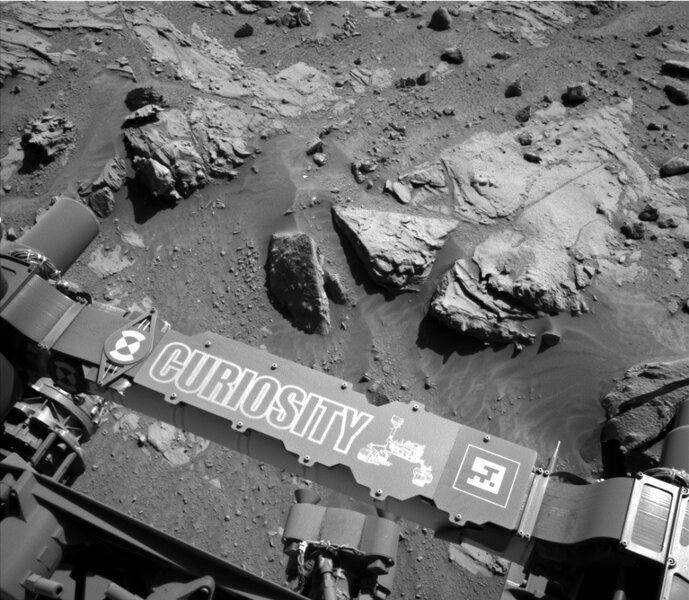Curiosity begins drilling into Martian rock
Loading...
In a landscape of sandstone outcroppings sculpted by Martian winds, NASA's Mars Curiosity Rover is preparing for its third rock-drilling mission. The one-ton rover will hammer dust out of a patch of sandstone to learn how the planet’s environment developed, and how it might have nurtured microbial life.
Curiosity arrived at its current location, called “the Kimberly,” on April 2, and is now perched aside a two-foot-wide patch of bedrock named “Winjana” after an Australian gorge. Like a careful archaeologist, the vehicle prepared a patch of the rock with a metal brush last weekend, and has since completed a trial drilling, to make sure the material won't harm the drill.
"In the brushed spot, we can see that the rock is fine-grained, its true color is much grayer than the surface dust, and some portions of the rock are harder than others, creating the interesting bumpy textures," said Curiosity science team member Melissa Rice of the California Institute of Technology, in a NASA press release. "All of these traits reinforce our interest in drilling here in order [to] understand the chemistry of the fluids that bound these grains together to form the rock."
The rover, which was launched in November 2011 and landed on Mars in August 2012, is driven by a nuclear generator containing enough plutonium-238 to get it through at least a few more years of operation. Its ultimate destination is the vast Mount Sharp, which sits on the horizon relative to the Kimberly, and which is expected to yield a treasure trove of geological information stretching deep into the past. "Think Grand Canyon, only a bigger stack of layered rocks," Joy Crisp, the mission's Deputy Project Scientist, told The Monitor. "We felt compelled to want to go there with our rover, to really figure out what that is telling us, what were those conditions. Was water around? Was it warm or cold? Was it acidic or not? Was it favorable for life?"
The mission had intended to send Curiosity straight to Mount Sharp, but got "sidetracked with very interesting things," says Dr. Crisp, including a 400-meter detour to study an area called Yellowknife Bay, last year. That side trip was well worth the delay, as Curiosity's first drill samples were found, through X-ray diffraction, to include clay minerals containing water, along with other clues that suggest the area may once have sat at the bottom of an ancient lake bed.
Along with seeking water, Curiosity is analyzing its samples for organic compounds that form the building blocks of life on Earth. So far, only a few simple ones have been found, in small amounts. "So, not enough to make a compelling case yet, for the search that we’re trying to do," says Crisp. "We would like to find more complicated compounds.”
The search for Martian water is generations old, but in 2006, NASA photos revealed pale markings in two gullies that appeared to descend slightly over time, suggesting that liquid water might actually be appearing on the planet’s surface in brief spurts. Colin Dundas, a research geologist with the US Geological Survey in Flagstaff, Ariz., says those markings may instead have been driven by the planet's "seasonal CO2 frost," but that similar, darker, sliding markings have been found elsewhere, called "recurring slope lineae," that are "the best candidates for liquid water on the surface at the moment.”
In general, explained the agency in a press release, “the atmosphere of Mars is so thin and the temperature so cold that liquid water cannot persist at the surface. It would rapidly evaporate or freeze.” But Dr. Dundas says that on warm slopes on warm seasons, Martian temperatures can exceed freezing. And that if these lineae were made by briny water, they could stay melted at lower temperatures, like sea water.
In 2008 NASA’s Phoenix Mars Lander was the first interplanetary lab to identify water in a Martian soil sample, when it heated the soil and detected water vapor.
Scientific views of Mars’ history are divided, according to NASA's online history of the planet. “According to one theory, Mars was once much warmer and wetter, with a thicker atmosphere; it may well have boasted lakes or oceans, rivers and rain. According to the other theory, Mars was always cold, but water trapped as underground ice was periodically released when heating caused ice to melt and gush forth onto the surface. In either case, the question of what happened to the water remains a mystery.”






